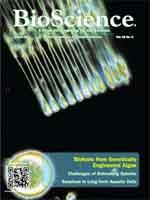Lost biomass of anadromous forage species resulting from the seventeenth to nineteenth century damming of waterways and from overharvest in the northeastern United States contributed to significant changes in coastal marine—terrestrial ecosystems. Historic alewife populations in Maine for the years 1600–1900 were assessed using analyses of nineteenth and twentieth century harvest records and waterway obstruction records dating to the 1600s. Obstructed spawning access in nine watersheds reduced the annual alewife productivity per watershed to 0%–16% of virgin estimates, equaling a cumulative lost fisheries production of 11 billion fish from 1750 to 1900. Including preharvest production, our estimates suggest a lost flux of anadromous forage fish increasing from 10 million fish per year in 1700 to 1.4 billion annually by 1850. Our results suggest a realignment of current restoration goals is needed to recognize oceanic and freshwater ecosystem interdependence and the gap between current targets and potential productivity.
How to translate text using browser tools
1 August 2012
Centuries of Anadromous Forage Fish Loss: Consequences for Ecosystem Connectivity and Productivity
Carolyn J. Hall,
Adrian Jordaan,
Michael G. Frisk
ACCESS THE FULL ARTICLE
It is not available for individual sale.
This article is only available to subscribers.
It is not available for individual sale.
It is not available for individual sale.

BioScience
Vol. 62 • No. 8
August 2012
Vol. 62 • No. 8
August 2012
applied ecology
coastal ecosystems
dams
fisheries
history




